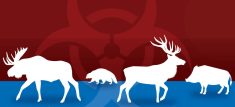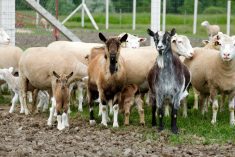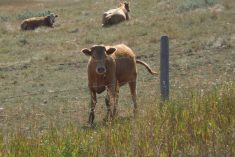A long winter coupled with a late and dry start to spring has stretched feed supplies across Alberta.
Which means any loss of hay to wildlife last winter was especially painful.
To avoid that grief — or at least lessen it — many producers on the Prairies have turned to three-dimensional fencing. Unlike typical fencing, which can be jumped by elk and deer, 3D fencing incorporates differing heights, widths, and depths, which can be tricky for wildlife to navigate.
They work because the eyes of elk, deer, and other ungulates are on the side of their heads, which is great when keeping watch for predators but not for depth perception.
Read Also

Farming Smarter receives financial boost from Alberta government for potato research
Farming Smarter near Lethbridge got a boost to its research equipment, thanks to the Alberta government’s increase in funding for research associations.
Typically, 3D fences consist of two electrified fences — a lower outer one with a higher fixed-post fence on the interior, with a gap of about three feet in between. The Peace River Forage Association of B.C. tested several variations of this basic design during a project from 2010-12. One version (using a 34-inch-high single-strand outer fence with a four-strand, 54-inch-high electric interior fence) was tested on a farm in the Carrot River area of Saskatchewan.
The farm had a hay yard (65×150 feet in size) that lost substantial amounts of hay to elk each winter. That changed after the 3D fencing was installed. Trail cameras found elk visiting the site and going right up to the outer fence, but not entering it.
A study in Manitoba (also using a Peace River Forage design, but with a three-wire interior fence with the top wire at 60 inches) also found 3D fencing was excellent at keeping out elk, but not as good at deterring deer.
“The deer seem to be less cautious and will go through or between,” said Elizabeth Nernberg, a livestock extension specialist with Manitoba’s Agriculture Department.
Initial findings from the study found 3D fences to be about 75 per cent effective compared to 90-plus per cent effectiveness with traditional barrier fences, which are generally eight to nine feet tall with woven wire.
But there’s a big cost difference.
The 3D fence in the Manitoba study cost $1.75 to $2 per linear foot (including $1 for materials). That compares to $6 a foot just for materials for a barrier fence and a total cost “pushing $11 to $12 per foot” when you factor in labour and equipment, said Nernberg.
The Grey Wooded Forage Association tested 3D fences on a pair of Sundre-area farms in the winter of 2015-16. Game cameras found some elk and mule deer were able to defeat the first version (single-strand outer, four-strand, four-foot-high inner fence). But after raising the inner fence by two feet with flex posts and tightening some slack wires, the fence did its job. No elk or deer entered the hay yards even though elk attractant was used.














